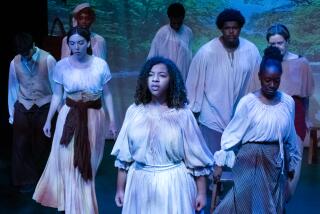The Arts at Black Mountain College by Mary Emma Harris (MIT: $50, hardcover; $30, paperback; 314 pp., illustrated)
- Share via
John Cage, composer; Robert Creeley, poet; Merce Cunningham, choreographer; Willem de Kooning, painter; Robert Duncan, poet; Francine du Plessix Gray, writer; Buckminster Fuller, architect; Robert Motherwell, painter; Charles Olson, poet; Robert Rauschenberg, painter; Paul Taylor, dancer--despite their diversity, these dominant figures shaping the avant-garde in post-war America had in common their participation in the education experience at Black Mountain.
Black Mountain was a small, experimental college founded by John Andrew Rice in the hills of North Carolina in 1933. During World War II, the exodus of European artists to America provided the college with an extraordinary faculty. Under the direction of Josef Albers, Black Mountain became a spiritual heir to Bauhaus ideas. In the 1950s, under Charles Olson, the college became a center for experimental writing.
Though it lasted less than a quarter-century and enrolled fewer than 1,200 students (55 actually graduated), Black Mountain became a legend in its own time.
In 1969, Mary Emma Harris enrolled as a graduate student in art history at the University of North Carolina at Chapel Hill. Born near the North Carolina coast, she had never heard of Black Mountain until starting work toward her master’s degree. Then, as she says, “if you’re interested in art history, you run into references to Black Mountain in so many monographs of contemporary artists” that she was surprised to discover that no book about the place existed. Her faculty adviser told her that one couldn’t be written because there was no documentation of the history of the college.
Out of curiosity, Harris contacted the state archives at Raleigh and learned that Charles Olson had deposited the Black Mountain papers there. In 1972, after Harris had begun her research, “Black Mountain: An Exploration in Community” was published by Martin Duberman, a history professor, but his book emphasized his personal response to the college. Taking 16 years to complete her project, Harris organized her material as a meticulous art historian, and the result is a stunning evocation of the remarkable college and its brilliant artists.
Though Harris never studied under Olson, she has observed his dictum that “art does not seek to describe but enact.” She has filled the pages of her book with photographs showing the crafts, ceramics and weaving, the dancing, concerts and “happenings,” as well as the paintings and sculptures. She is a fine historian, proceeding chronologically and giving equal space to the entire achievement of Black Mountain, the work of both men and women.
Crammed full of detail, the book “enacts” Black Mountain because Harris is an ideal guide, unobtrusive yet perceptive, eloquently summarizing her knowledge of her subject:
“Black Mountain College has stood as a symbol of academic freedom, of experimentation in the arts, and of the importance of the arts to American life. . . . Its nature was mercurial, its spirit experimental, its setting modest . . . there was a concern with wholeness: the education of head, heart, and hand. Perceived as a field of forces, it was far more intense than a conventional educational institution, and it is this energy released that continues to send vibrations throughout American cultural life.”
More to Read
The biggest entertainment stories
Get our big stories about Hollywood, film, television, music, arts, culture and more right in your inbox as soon as they publish.
You may occasionally receive promotional content from the Los Angeles Times.










